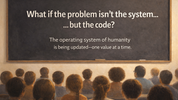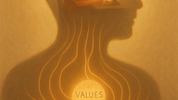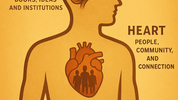Last Thursday afternoon, I witnessed something that left a deep mark. Two drunken young men, laughing, arguing, and brawling in the middle of the shopping street, while a crowd gathered to watch.
But it wasn’t the drunkenness that struck me most, it was the crowd.
Mothers with children, fellow tourists, workers, teenagers … all just standing there, silently watching. Emotionless. Desensitised. Not a murmur of concern. Only one person broke the spell: an elderly woman pulling a shopping trolley.
She didn’t flinch. She didn’t hesitate. She strode right up to them, looked them in the eyes, and shouted, “Behave yourselves!” It wasn’t timid — it was fierce, clear, and deeply human.
She was the exception - a lone ripple of realness in a sea of frozen faces.
When the police arrived, sirens blaring, not a single head turned in surprise. When the lads were taken away, the crowd wordlessly drifted off. Back to shopping. Back to scrolling. As if nothing had happened.
And I wondered:
Is this the new normal?
It reminded me of the social media reels we all know, one shocking story after another, tragedy after tragedy, delivered with algorithmic precision. In a world where we’re exposed to an endless stream of sensationalised headlines, are we losing our capacity to feel? Is humanity slowly forgetting what it means to care?
And yet… perhaps it’s more complex than it seems.
The Illusion of a Declining World
There’s a psychological phenomenon known as the Baader-Meinhof effect, or frequency illusion. Once we become aware of something (say, bad behaviour or tragedy), we begin noticing it more frequently. It’s not that these events are happening more often; it’s that our attention has been trained to spot them.
As Professor Anina Rich explains:
“There are two parts to it. One part is the perception of increased frequency; the second part is a confirmation bias, where you believe it didn’t happen before at the same rate. But in reality, the frequency hasn’t changed — you just weren’t noticing it.”
Add to that the fact that bad news consistently outperforms good news in clicks and shares, and you start to see the spiral.
Where thought goes, energy flows.
Our attention shapes our worldview. And when our worldview darkens, our behaviours follow.
A World We’re Not Designed For
Neurologically, we are wired to notice threats; it’s part of our survival system. But in a world of 24/7 news and global crises delivered straight to our palms, our nervous systems are overwhelmed.
Consider this:
- Cortisol, our primary stress hormone, spikes when we consume negative news. Over time, chronic levels lead to anxiety and burnout. (Sapolsky, R. M. (2004). Why Zebras Don't Get Ulcers. Henry Holt and Co.
- The amygdala, our brain’s fear centre, becomes hyperactive, keeping us on edge.
- Our natural negativity bias means we give more weight to what’s wrong than what’s right. (Rozin, P., & Royzman, E. B. (2001). Negativity bias, negativity dominance, and contagion. Personality and Social Psychology Review, 5(4), 296-320)
- Repeated exposure desensitises us, reducing empathy, increasing withdrawal, and draining mental energy.
- And perhaps most crucially: we start believing the world is worse than it really is, which fuels hopelessness, apathy, and poor decision-making.
In other words:
We’re not apathetic... we’re overloaded.
Two Roads Diverge…
If we continue on this path of passive consumption, unconscious reaction, and emotional detachment, the spiral deepens.
- Communities fracture.
- Compassion shrinks.
- Fear replaces connection.
And in time, we may lose our very sense of humanity.
But there is another way. There always is.
The Brighter Path — A Conscious Reclaiming
We must learn to be fans of what we want, not of what we don’t. The shift begins internally with awareness and ripples outward.
Here are a few simple, powerful strategies to begin redirecting our inner compass:
1. Curate Your Feed, Curate Your Mind
Choose to follow voices that uplift, inform, and inspire.
Balance truth with hope.
Don’t numb — but don’t drown either.
2. Positive Priming and Neuroplasticity
Our brains can be rewired, regardless of our age. With consistent, simple daily practices, like journaling, meditation, or affirmations such as:
“I Am Loving,” “I Am Calm,” or “I Am Compassion” - we build new thought patterns. This isn’t fluff. These are tools of transformation.
3. Connect with Real People
- Digital life can desensitise.
- Human life re-sensitises.
- Ask your neighbour how they’re doing — and mean it.
- Listen. Be present. Be real.
4. Be the Pattern Interrupt
In that city centre moment, only one person had the courage to step forward. A woman with a shopping trolley and fire in her voice. What would our world be like if there were more like her?
We can be that ripple.
That unexpected smile. That moment of eye contact that says, “I see you.”
5. Visualise the World You Want
Thoughts have power.
Visualisation isn’t just imagination — it’s creation.
Picture a world of kindness, connection, and care.
Let that image live in your mind long enough to shift your energy, and others will feel it too.
You Are Not Powerless. You Are Powerful.
Here’s what neuroscience tells us: We are only consciously aware of 0.000005% of the data our brains are processing.
That means the tiniest fraction of our experience is shaped by conscious attention, and yet that fraction has the power to change everything.
Our focus is our superpower.
Our thoughts shape our feelings, our decisions, our relationships, and our life.
We are not victims of information.
We are the architects of meaning.
Final Thought
We’re standing at a crossroads.
One path leads to division, desensitisation, and disconnection. The other, though quieter, leads to reawakening. To presence. To collective healing. To understanding.
Sometimes, the most powerful reminder of our shared humanity is someone refusing to stand by and watch.
Let’s choose that path.
Let’s choose to feel again.
To care again.
To reclaim our focus.
To remember who we are.
Be a fan of what you want to see in the world.
Speak it. Live it. Amplify it.
It’s our choice.
 unknownx500
unknownx500





